Healing Evaluation of Asphalt Mixtures with Polymer Capsules Containing Rejuvenator under Different Water Solutions
Abstract
:1. Introduction
2. Materials and Experimental Methods
2.1. Raw Materials
2.2. Preparation of Polymer Capsules
2.3. Performance Evaluation of Polymer Capsules
2.4. Fabrication of Asphalt Concrete with Polymer Capsules
2.5. Healing Efficacy Measurement of Asphalt Concrete with Polymer Capsules
2.6. Quantification of Loading-Released Rejuvenator Content in Asphalt Binder Release from Capsules after Different Solution Treatments
2.7. Rheological Characteristics Test of the Asphalt Binders Extracted from Asphalt Concrete
3. Results and Discussion
3.1. Fundamental Characteristics of Prepared Polymer Capsules
3.1.1. Morphological Structure
3.1.2. Mechanical Strength
3.1.3. Thermal Stability and Relative Rejuvenator Content
3.2. Healing Evaluation of Asphalt Concrete
3.2.1. Healing Ratio of Asphalt Concrete following Various Solution Treatments
3.2.2. Healing Assessment of Asphalt Concrete after Water Solution Treatment Different Times
3.3. Rejuvenator Release Ratio of Capsules within Asphalt Concrete under Dry Healing Conditions after Cyclic Loading
3.4. Rejuvenator Content of Asphalt Binder Extracted from Asphalt Concrete under Solution Treatment after Cyclic Loading
3.5. Rheological Performance of Extracted Asphalt Binder after Different Solution Treatments
4. Conclusions
- (1)
- The polymer capsules exhibit an internal multichamber structure and demonstrate favorable mechanical and thermal durability, satisfying the criteria for use in laboratory asphalt concrete production.
- (2)
- The capsules with multiple chambers exhibited a gradual rejuvenator release pattern, thereby imparting long-term healing potential to asphalt concrete. The solution healing condition decreased the remaining rejuvenator in the extracted asphalt binder after being subjected to cyclic loading.
- (3)
- The utilization of capsules in asphalt concrete resulted in higher healing ratios compared to noncapsule asphalt concrete, both under dry and solution healing conditions, due to the released rejuvenator via cyclic loading. Meanwhile, the healing efficacy of asphalt concrete, both with and without capsules, was found to be diminished by the moisture intrusion and ion erosion resulting from the solution treatment. The alkali solution has the most adverse effect on the enhancement in healing efficacy for asphalt concrete.
- (4)
- The healing efficacy of asphalt concrete containing capsules in a dry curing environment increased marginally as the healing duration was prolonged, while the asphalt concrete with capsules exhibited lower healing efficacy after a longer healing period due to the severe erosion effect in the crack zone.
- (5)
- The simultaneous impact of moisture intrusion and ion erosion was observed to enhance the complex modulus of asphalt binder while reducing its phase angle, thereby diminishing the healing capacity of the asphalt binder.
Author Contributions
Funding
Institutional Review Board Statement
Informed Consent Statement
Data Availability Statement
Conflicts of Interest
References
- Amirbayev, Y.; Yelshibayev, A.; Nugmanova, A. Characterization of asphalt bitumens and asphalt concretes modified with carbon powder. Case Stud. Constr. Mater. 2022, 17, 01554. [Google Scholar] [CrossRef]
- Wan, P.; Liu, Q.; Wu, S.; Zhao, Z.; Chen, S.; Zou, Y.; Rao, W.; Yu, X. A novel microwave induced oil release pattern of calcium alginate/nano-Fe3O4 composite capsules for asphalt self-healing. J. Clean. Prod. 2021, 297, 126721. [Google Scholar] [CrossRef]
- Hong, R.-B.; Wu, J.-R.; Cai, H.-B. Low-temperature crack resistance of coal gangue powder and polyester fibre asphalt mixture. Constr. Build. Mater. 2020, 238, 117678. [Google Scholar] [CrossRef]
- Li, J.; Yu, J.; Wu, S.; Xie, J. The Mechanical Resistance of Asphalt Mixture with Steel Slag to Deformation and Skid Degradation Based on Laboratory Accelerated Heavy Loading Test. Materials 2022, 15, 911. [Google Scholar] [CrossRef]
- Hu, Z.; Zhang, H.; Wang, S.; Xu, T. Thermal-oxidative aging mechanism of asphalt binder based on isothermal thermal analysis at the SARA level. Constr. Build. Mater. 2020, 255, 119349. [Google Scholar] [CrossRef]
- Cong, P.; Chen, Z.; Ge, W. Influence of moisture on the migration of asphalt components and the adhesion between asphalt binder and aggregate. Constr. Build. Mater. 2023, 385, 131513. [Google Scholar] [CrossRef]
- Li, Y.; Feng, J.; Wu, S.; Chen, A.; Kuang, D.; Bai, T.; Gao, Y.; Zhang, J.; Li, L.; Wan, L.; et al. Review of ultraviolet ageing mechanisms and anti-ageing methods for asphalt binders. J. Road Eng. 2022, 2, 137–155. [Google Scholar] [CrossRef]
- Jiang, W.; Yuan, D.; Shan, J.; Ye, W.; Lu, H.; Sha, A. Experimental study of the performance of porous ultra-thin asphalt overlay. Int. J. Pavement Eng. 2020, 23, 2049–2061. [Google Scholar] [CrossRef]
- Zhou, B.; Gong, G.; Liu, Y.; Guo, M.; Wang, C. Technical and environmental performance assessment of VOCs inhibited asphalt binders and mixtures. Transport. Res. D-Tr E. 2023, 124, 103931. [Google Scholar] [CrossRef]
- Yang, C.; Wu, S.; Cui, P.; Amirkhanian, S.; Zhao, Z.; Wang, F.; Zhang, L.; Wei, M.; Zhou, X.; Xie, J. Performance characterization and enhancement mechanism of recycled asphalt mixtures involving high RAP content and steel slag. J. Clean. Prod. 2022, 336, 130484. [Google Scholar] [CrossRef]
- Yang, C.; Wu, S.; Xie, J.; Amirkhanian, S.; Zhao, Z.; Xu, H.; Wang, F.; Zhang, L. Development of blending model for RAP and virgin asphalt in recycled asphalt mixtures via a micron-Fe3O4 tracer. J. Clean. Prod. 2023, 383, 135407. [Google Scholar] [CrossRef]
- Yuan, D.; Jiang, W.; Sha, A.; Xiao, J.; Wu, W.; Wang, T. Technology method and functional characteristics of road thermoelectric generator system based on Seebeck effect. Appl. Energy 2023, 331, 120459. [Google Scholar] [CrossRef]
- Sun, D.; Sun, G.; Zhu, X.; Guarin, A.; Li, B.; Dai, Z.; Ling, J. A comprehensive review on self-healing of asphalt materials: Mechanism, model, characterization and enhancement. Adv. Colloid Interface Sci. 2018, 256, 65–93. [Google Scholar] [CrossRef] [PubMed]
- Cabette, M.; Pais, J.; Micaelo, R. Extrinsic healing of asphalt mixtures: A review. Road. Mater. Pavement. 2023, 1–29. [Google Scholar] [CrossRef]
- Wan, P.; Wu, S.; Liu, Q.; Zou, Y.; Zhao, Z.; Chen, S. Recent advances in calcium alginate hydrogels encapsulating rejuvenator for asphalt self-healing. J. Road Eng. 2022, 2, 181–220. [Google Scholar] [CrossRef]
- García, Á. Self-healing of open cracks in asphalt mastic. Fuel 2012, 93, 264–272. [Google Scholar] [CrossRef]
- Gaweł, I.; Piłat, J.; Radziszewski, P.; Kowalski, K.; Król, J. Rubber Modified Bitumen; Elsevier: Amsterdam, The Netherlands, 2011; pp. 72–97. [Google Scholar]
- Yadykova, A.Y.; Ilyin, S.O. Nanocellulose-stabilized bitumen emulsions as a base for preparation of nanocomposite asphalt binders. Carbohydr. Polym. 2023, 313, 120896. [Google Scholar] [CrossRef]
- Dai, Q.; Wang, Z.; Mohd Hasan, M.R. Investigation of induction healing effects on electrically conductive asphalt mastic and asphalt concrete beams through fracture-healing tests. Constr. Build. Mater. 2013, 49, 729–737. [Google Scholar] [CrossRef]
- Xu, H.; Wu, S.; Chen, A.; Zou, Y. Influence of erosion factors (time, depths and environment) on induction heating asphalt concrete and its mechanism. J. Clean. Prod. 2022, 363, 132521. [Google Scholar] [CrossRef]
- Liu, J.; Zhang, T.; Guo, H.; Wang, Z.; Wang, X. Evaluation of self-healing properties of asphalt mixture containing steel slag under microwave heating: Mechanical, thermal transfer and voids microstructural characteristics. J. Clean. Prod. 2022, 342, 130932. [Google Scholar] [CrossRef]
- Wang, R.; Xiong, Y.; Ma, X.; Guo, Y.; Yue, M.; Yue, J. Investigating the differences between steel slag and natural limestone in asphalt mixes in terms of microscopic mechanism, fatigue behavior and microwave-induced healing performance. Constr. Build. Mater. 2022, 328, 127107. [Google Scholar] [CrossRef]
- Garcia, A.; Austin, C.J.; Jelfs, J. Mechanical properties of asphalt mixture containing sunflower oil capsules. J. Clean. Prod. 2016, 118, 124–132. [Google Scholar] [CrossRef]
- Li, B.; Sun, G.; Sun, D.; Lu, T.; Ma, J.; Deng, Y. Survival and activation behavior of microcapsules in self-healing asphalt mixture. Constr. Build. Mater. 2020, 260, 119719. [Google Scholar] [CrossRef]
- Sun, D.; Li, B.; Ye, F.; Zhu, X.; Lu, T.; Tian, Y. Fatigue behavior of microcapsule-induced self-healing asphalt concrete. J. Clean. Prod. 2018, 188, 466–476. [Google Scholar] [CrossRef]
- Yamaç, Ö.E.; Yilmaz, M.; Yalçın, E.; Kök, B.V.; Norambuena-Contreras, J.; Garcia, A. Self-healing of asphalt mastic using capsules containing waste oils. Constr. Build. Mater. 2021, 270, 121417. [Google Scholar] [CrossRef]
- Al-Mansoori, T.; Norambuena-Contreras, J.; Micaelo, R.; Garcia, A. Self-healing of asphalt mastic by the action of polymeric capsules containing rejuvenators. Constr. Build. Mater. 2018, 161, 330–339. [Google Scholar] [CrossRef]
- Norambuena-Contreras, J.; Yalcin, E.; Hudson-Griffiths, R.; García, A. Mechanical and Self-Healing Properties of Stone Mastic Asphalt Containing Encapsulated Rejuvenators. J. Mater. Civil. Eng. 2019, 31, 04019052. [Google Scholar] [CrossRef]
- Norambuena-Contreras, J.; Garcia, A. Self-healing of asphalt mixture by microwave and induction heating. Mater. Des. 2016, 106, 404–414. [Google Scholar] [CrossRef]
- Yadykova, A.Y.; Ilyin, S.O. Rheological and adhesive properties of nanocomposite bitumen binders based on hydrophilic or hydrophobic silica and modified with bio-oil. Constr. Build. Mater. 2022, 342, 127946. [Google Scholar] [CrossRef]
- Zhang, H.; Bai, Y.; Cheng, F. Rheological and self-healing properties of asphalt binder containing microcapsules. Constr. Build. Mater. 2018, 187, 138–148. [Google Scholar] [CrossRef]
- Xue, B.; Wang, H.; Pei, J.; Li, R.; Zhang, J.; Fan, Z. Study on self-healing microcapsule containing rejuvenator for asphalt. Constr. Build. Mater. 2017, 135, 641–649. [Google Scholar] [CrossRef]
- Wang, X.; Guo, G.; Zou, F.; Zhao, H.; Li, Y. Enhancing self-healing properties of microcrack on aged asphalt incorporating with microcapsules encapsulating rejuvenator. Constr. Build. Mater. 2022, 344, 128123. [Google Scholar] [CrossRef]
- Munir Ozdemir, A.; Yilmaz, M.; Yalcin, E.; Vural Kok, B.; Norambuena-Contreras, J.; Garcia, A. Effects of Capsules Containing Waste Oils on the Mechanical Properties of Hot Mix Asphalt: Experimental Approach. J. Mater. Civil. Eng. 2021, 33, 04021242. [Google Scholar] [CrossRef]
- Garcia-Hernández, A.; Salih, S.; Ruiz-Riancho, I.; Norambuena-Contreras, J.; Hudson-Griffiths, R.; Gomez-Meijide, B. Self-healing of reflective cracks in asphalt mixtures by the action of encapsulated agents. Constr. Build. Mater. 2020, 252, 118929. [Google Scholar] [CrossRef]
- Li, Y.; Hao, P.; Zhang, M. Fabrication, characterization and assessment of the capsules containing rejuvenator for improving the self-healing performance of asphalt materials: A review. J. Clean. Prod. 2021, 287, 125079. [Google Scholar] [CrossRef]
- Riara, M.; Tang, P.; Mo, L.; Hong, W.; Chen, M.; Wu, S. Evaluation of moisture and temperature effect on crack healing of asphalt mortar and mixtures using healing agents. Constr. Build. Mater. 2018, 177, 388–394. [Google Scholar] [CrossRef]
- Chen, M.; Leng, B.; Wu, S.; Sang, Y. Physical, chemical and rheological properties of waste edible vegetable oil rejuvenated asphalt binders. Constr. Build. Mater. 2014, 66, 286–298. [Google Scholar] [CrossRef]
- Ji, J.; Yao, H.; Suo, Z.; You, Z.; Li, H.; Xu, S.; Sun, L. Effectiveness of Vegetable Oils as Rejuvenators for Aged Asphalt Binders. J. Mater. Civ. Eng. 2017, 29, D4016003. [Google Scholar] [CrossRef]
- Casado-Barrasa, R.; López-Montero, T.; Castro-Fresno, D.; Miró, R. Evaluation of the rejuvenation of asphalt by means of oil-saturated porous aggregates. Constr. Build. Mater. 2022, 318. [Google Scholar] [CrossRef]
- Wang, H.; Liu, Q.; Wu, J.; Wan, P.; Zhao, F. Self-Healing Performance of Asphalt Concrete with Ca-Alginate Capsules under Low Service Temperature Conditions. Polymers 2022, 15, 199. [Google Scholar] [CrossRef]
- Wan, P.; Wu, S.; Liu, Q.; Xu, H.; Wang, H.; Peng, Z.; Rao, W.; Zou, Y.; Zhao, Z.; Chen, S. Self-healing properties of asphalt concrete containing responsive calcium alginate/nano-Fe3O4 composite capsules via microwave irradiation. Constr. Build. Mater. 2021, 310, 125258. [Google Scholar] [CrossRef]
- Wan, P.; Wu, S.; Liu, Q.; Wang, H.; Zhao, F.; Wu, J.; Niu, Y.; Ye, Q. Sustained-release calcium alginate/diatomite capsules for sustainable self-healing asphalt concrete. J. Clean. Prod. 2022, 372, 133639. [Google Scholar] [CrossRef]
- Wan, P.; Liu, Q.; Wu, S.; Zou, Y.; Zhao, F.; Wang, H.; Niu, Y.; Ye, Q. Dual responsive self-healing system based on calcium alginate/Fe3O4 capsules for asphalt mixtures. Constr. Build. Mater. 2022, 360, 129585. [Google Scholar] [CrossRef]
- Menapace, I.; Masad, E. The influence of moisture on the evolution of the microstructure of asphalt binders with aging. Road. Mater. Pavement 2018, 21, 331–346. [Google Scholar] [CrossRef]
- Noguera, J.A.H.; Quintana, H.A.R.; Gómez, W.D.F. The influence of water on the oxidation of asphalt cements. Constr. Build. Mater. 2014, 71, 451–455. [Google Scholar] [CrossRef]
- Zhang, K.; Luo, Y.; Xie, W.; Wu, J. Evaluation of road performance and adhesive characteristic of asphalt binder in salt erosion environment. Mater. Today Commun. 2020, 25, 101593. [Google Scholar] [CrossRef]
- Zhou, P.; Wang, W.; Zhu, L.; Wang, H.; Ai, Y. Study on Performance Damage and Mechanism Analysis of Asphalt under Action of Chloride Salt Erosion. Materials 2021, 14, 3089. [Google Scholar] [CrossRef]
- Xu, R. Study on the Effect of Sodium Erosion on Asphalt Self-Healing and Fatigue Performance. Master’s Thesis, Guangxi University, Nanning, China, 2020. [Google Scholar]
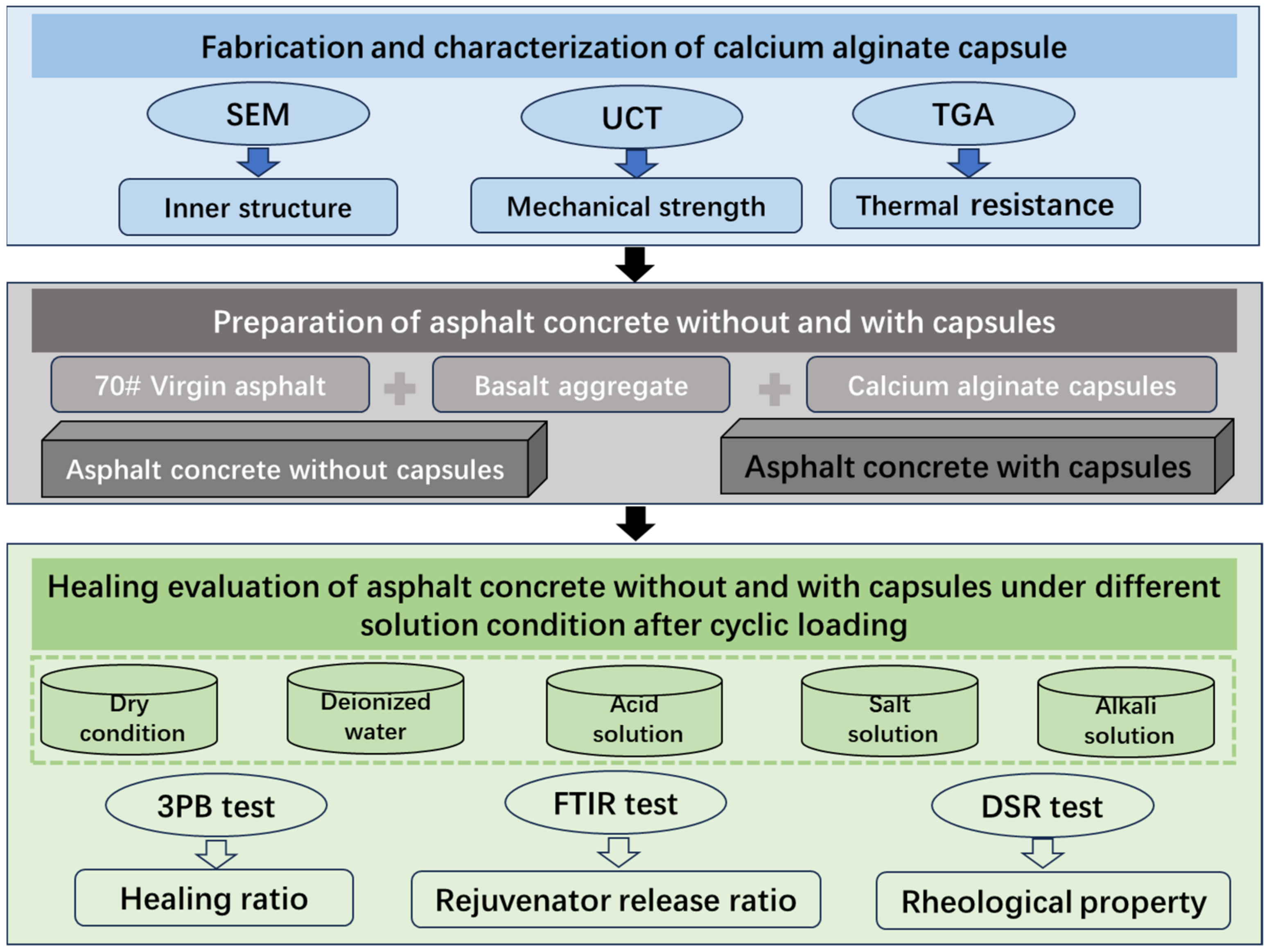

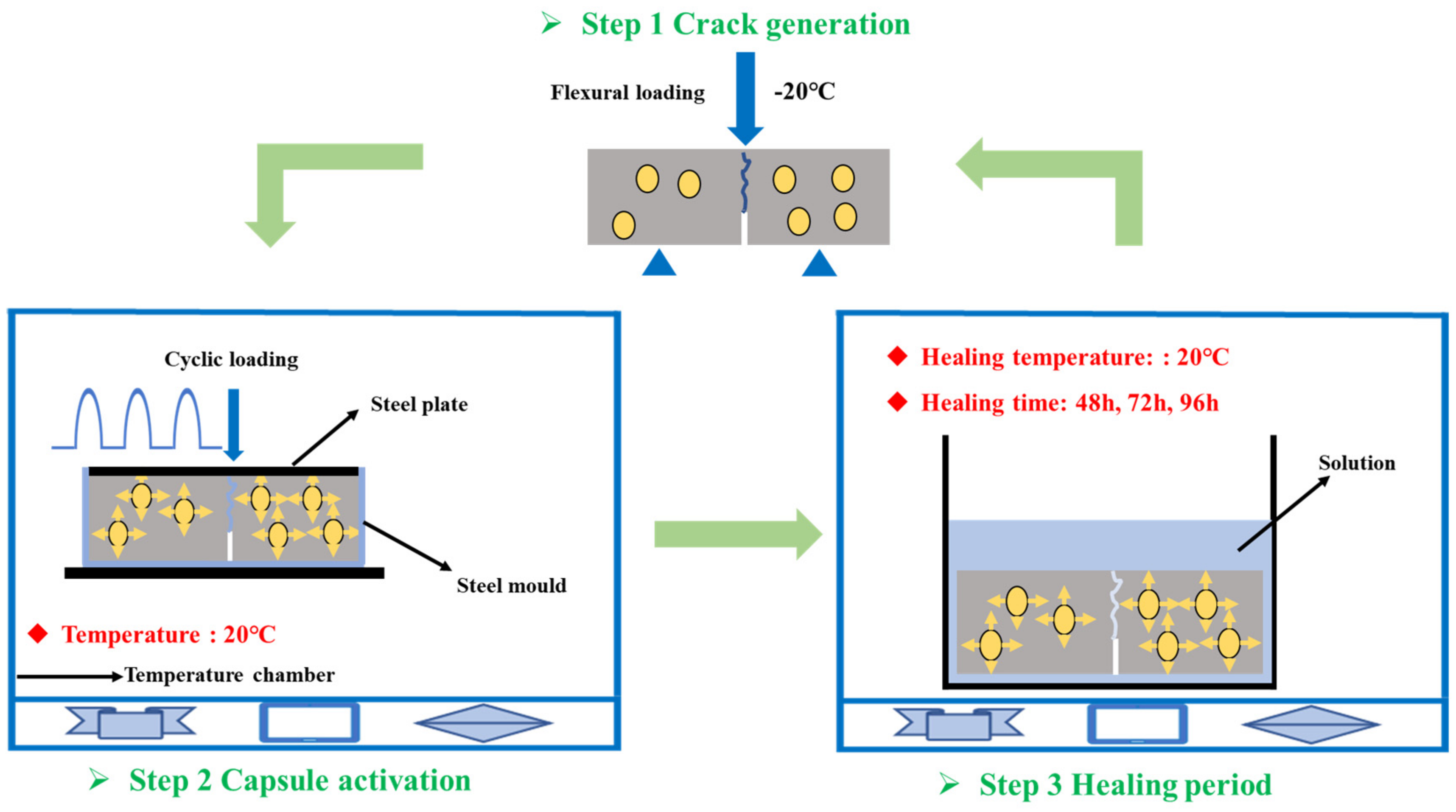


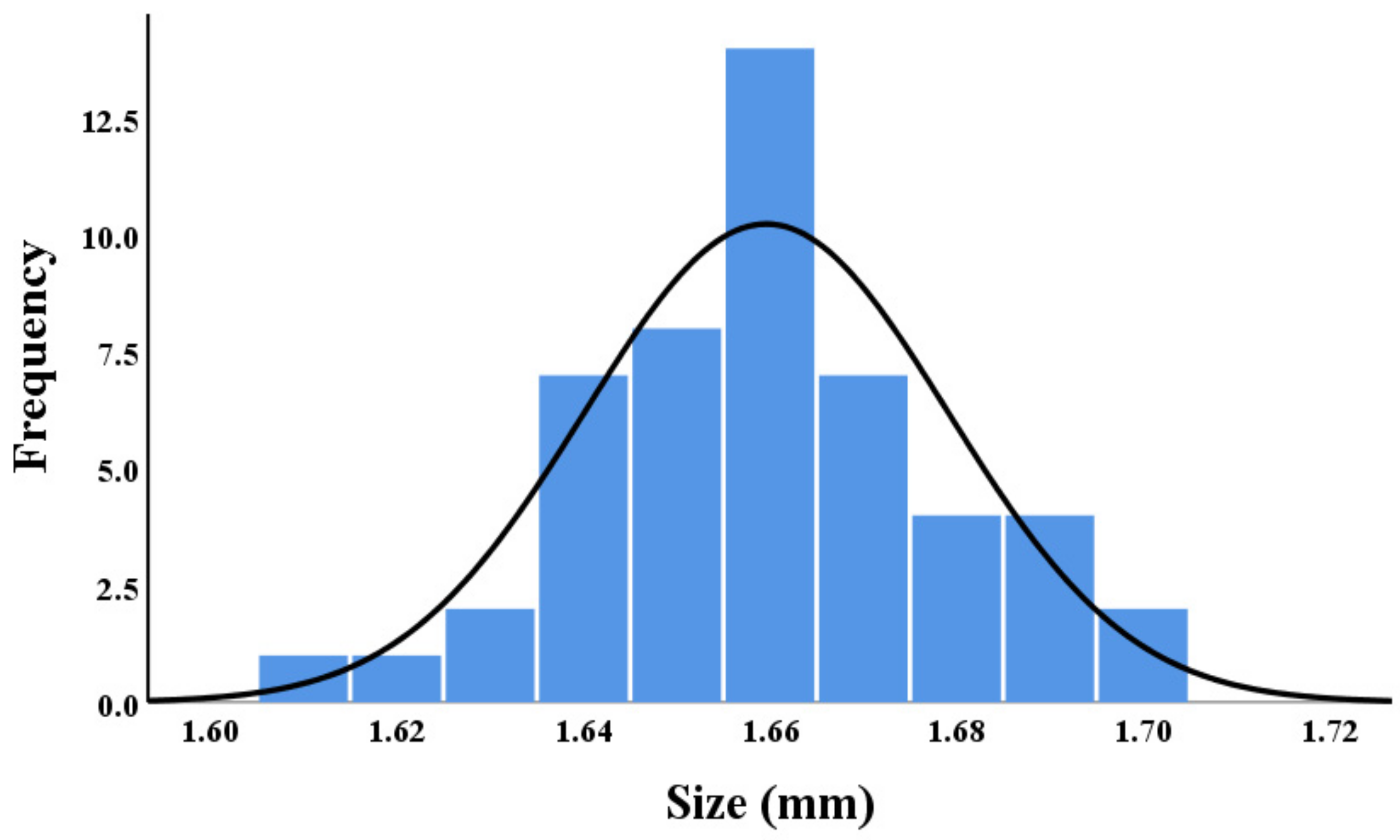
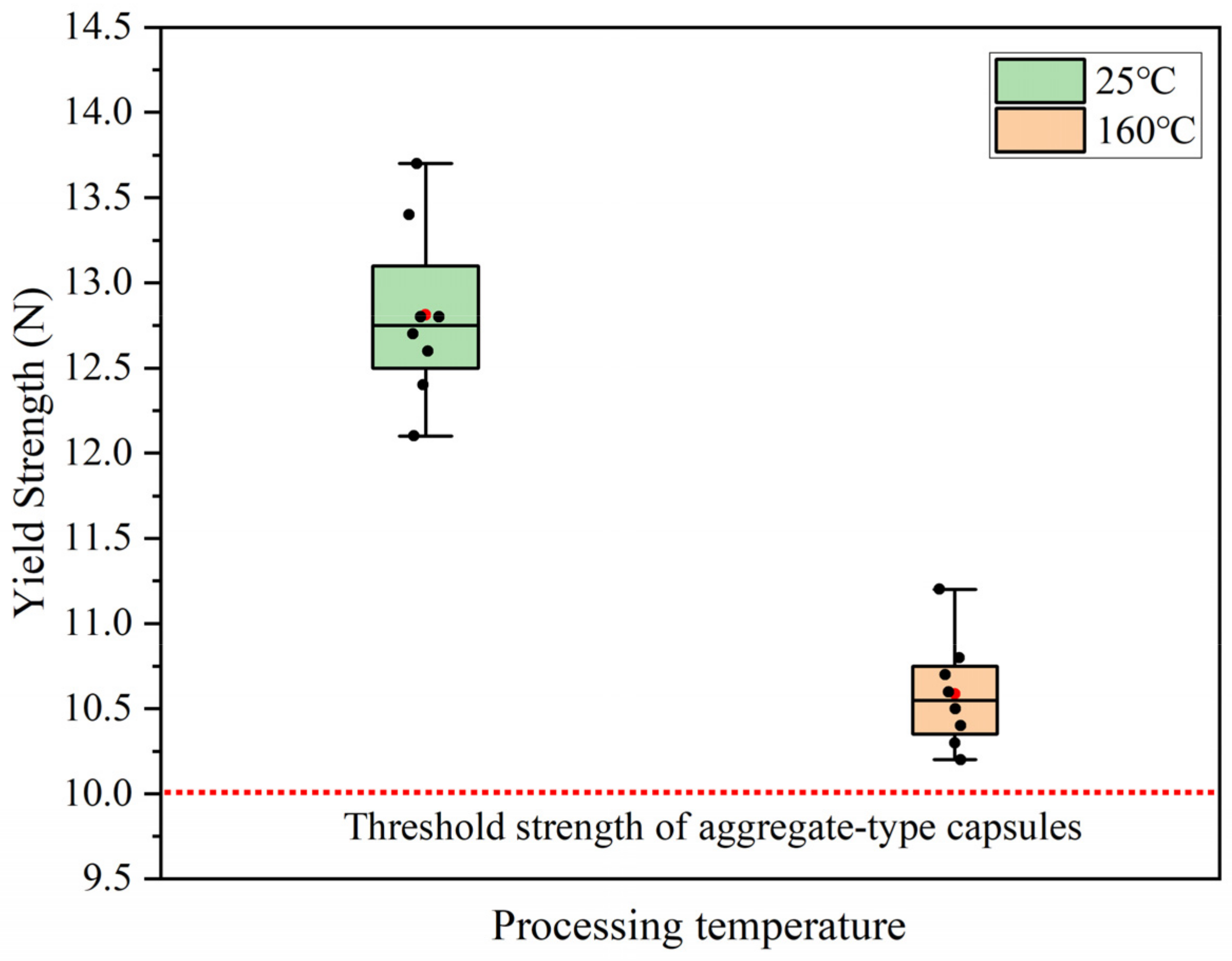
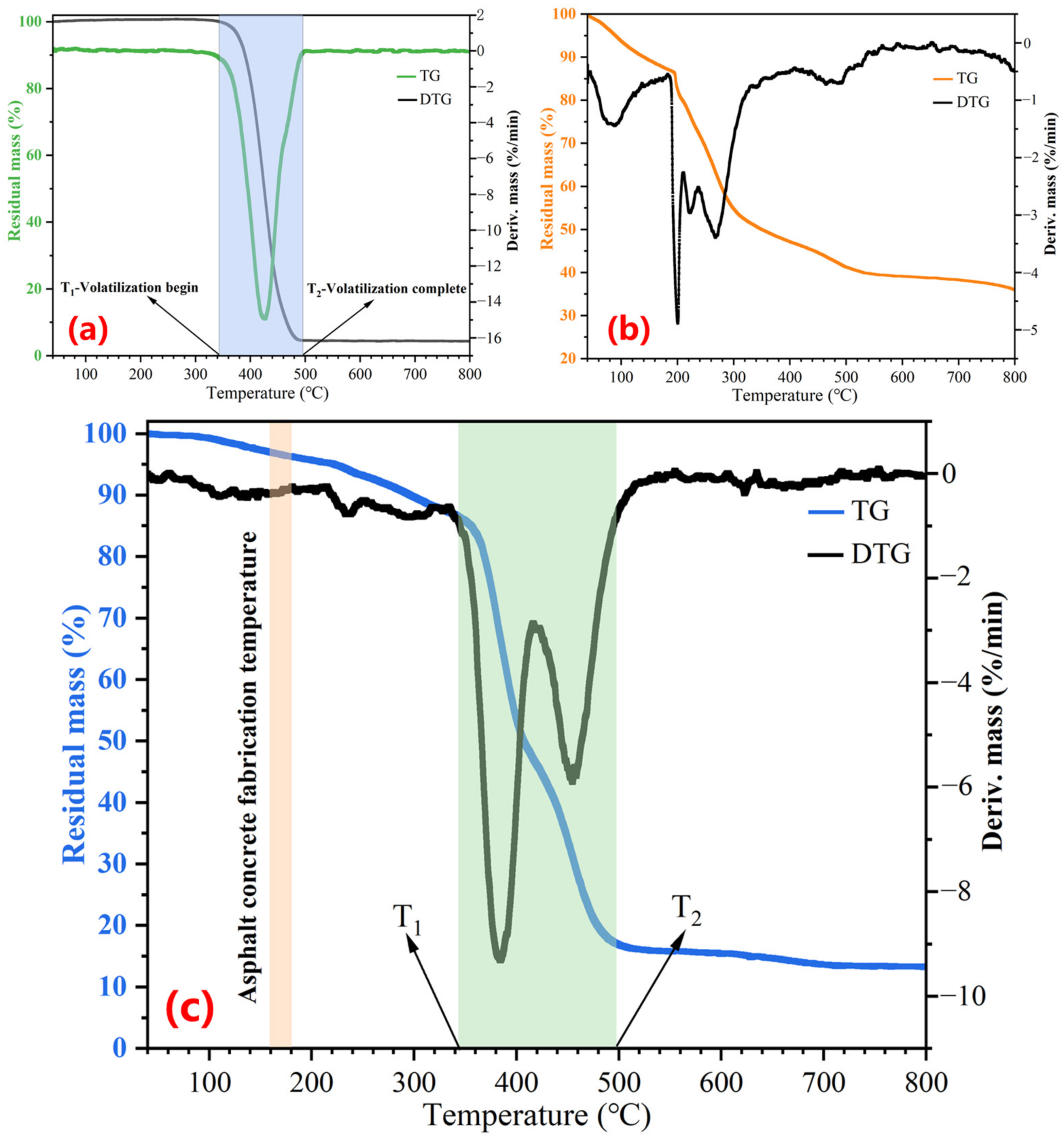

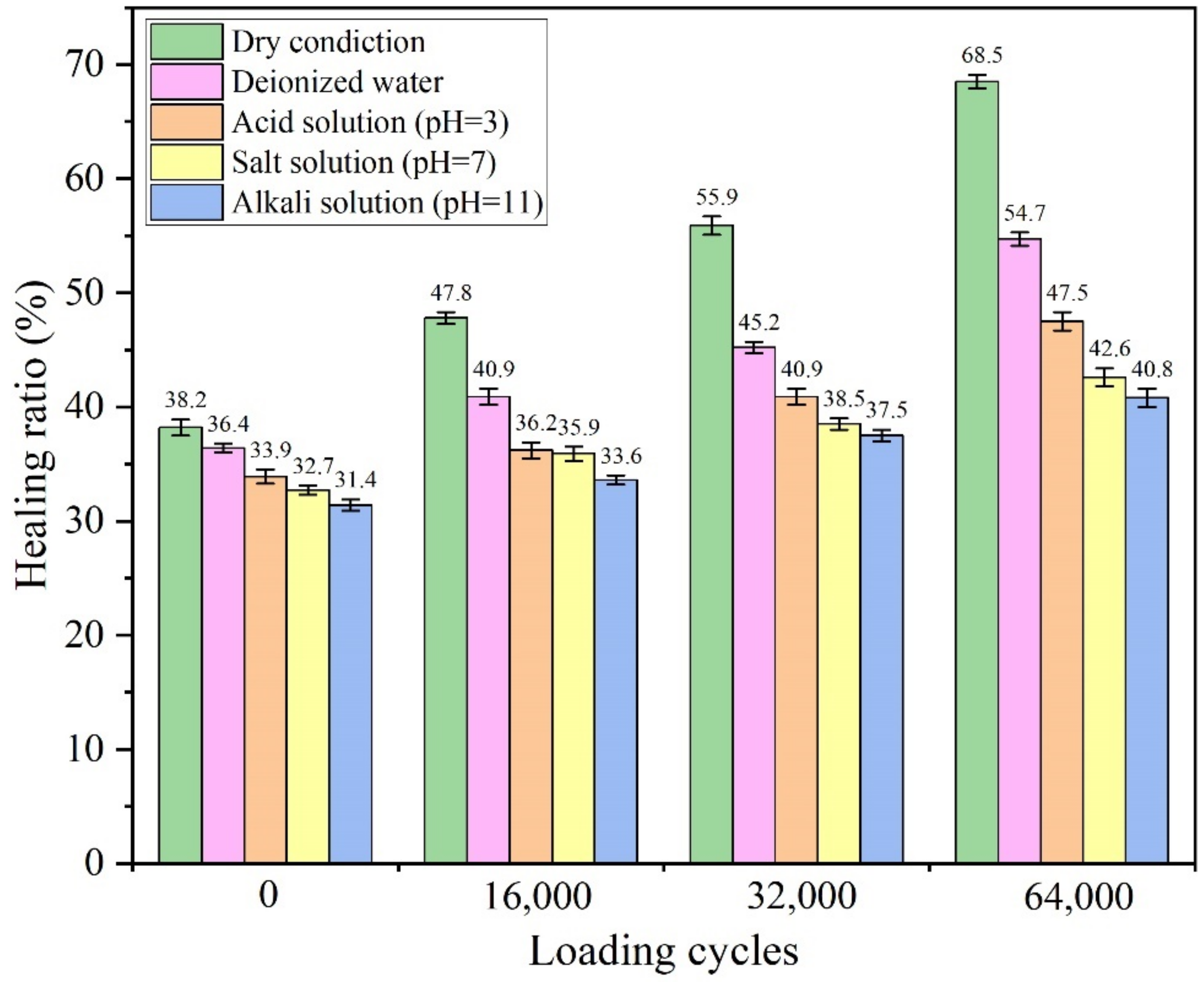

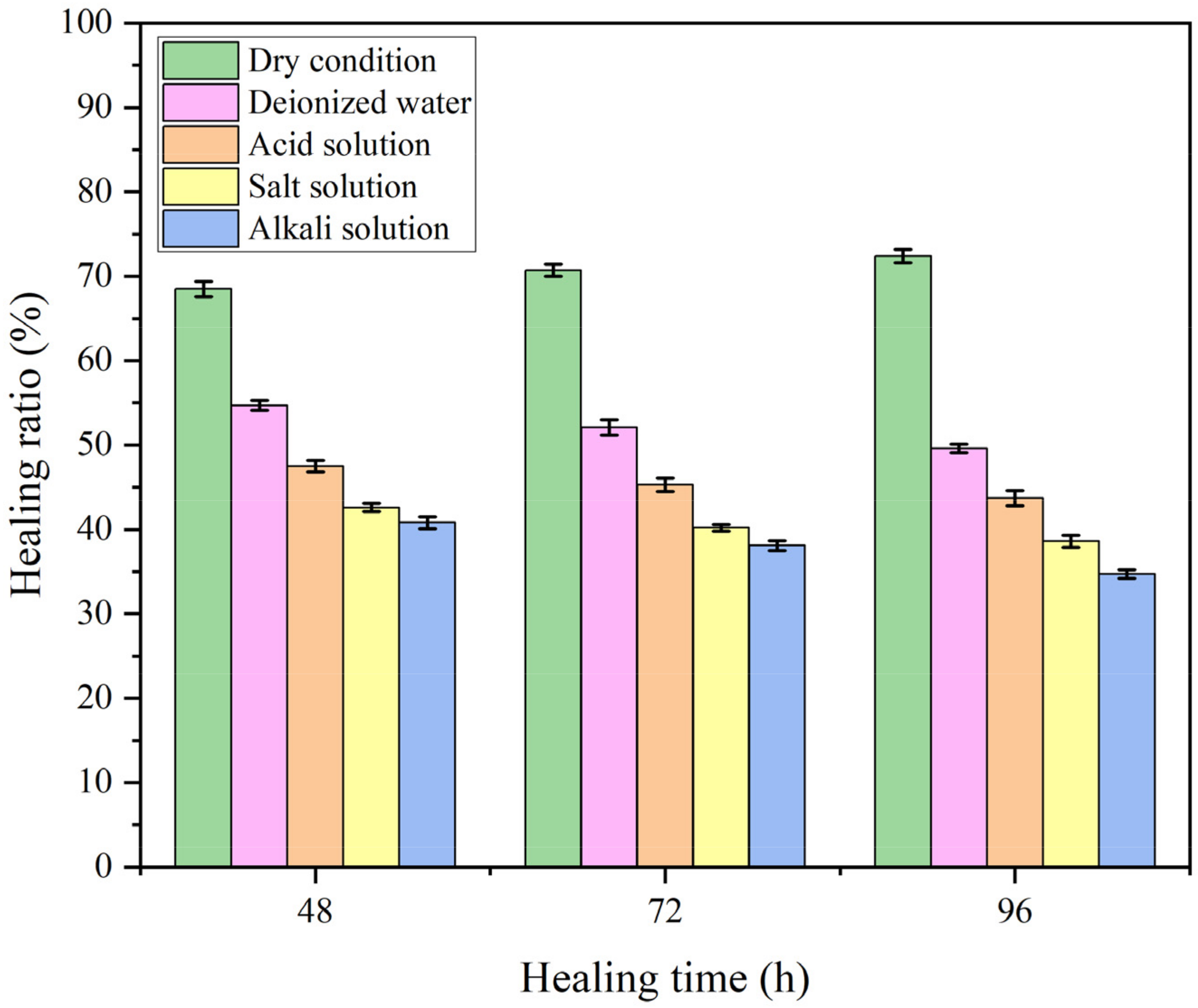

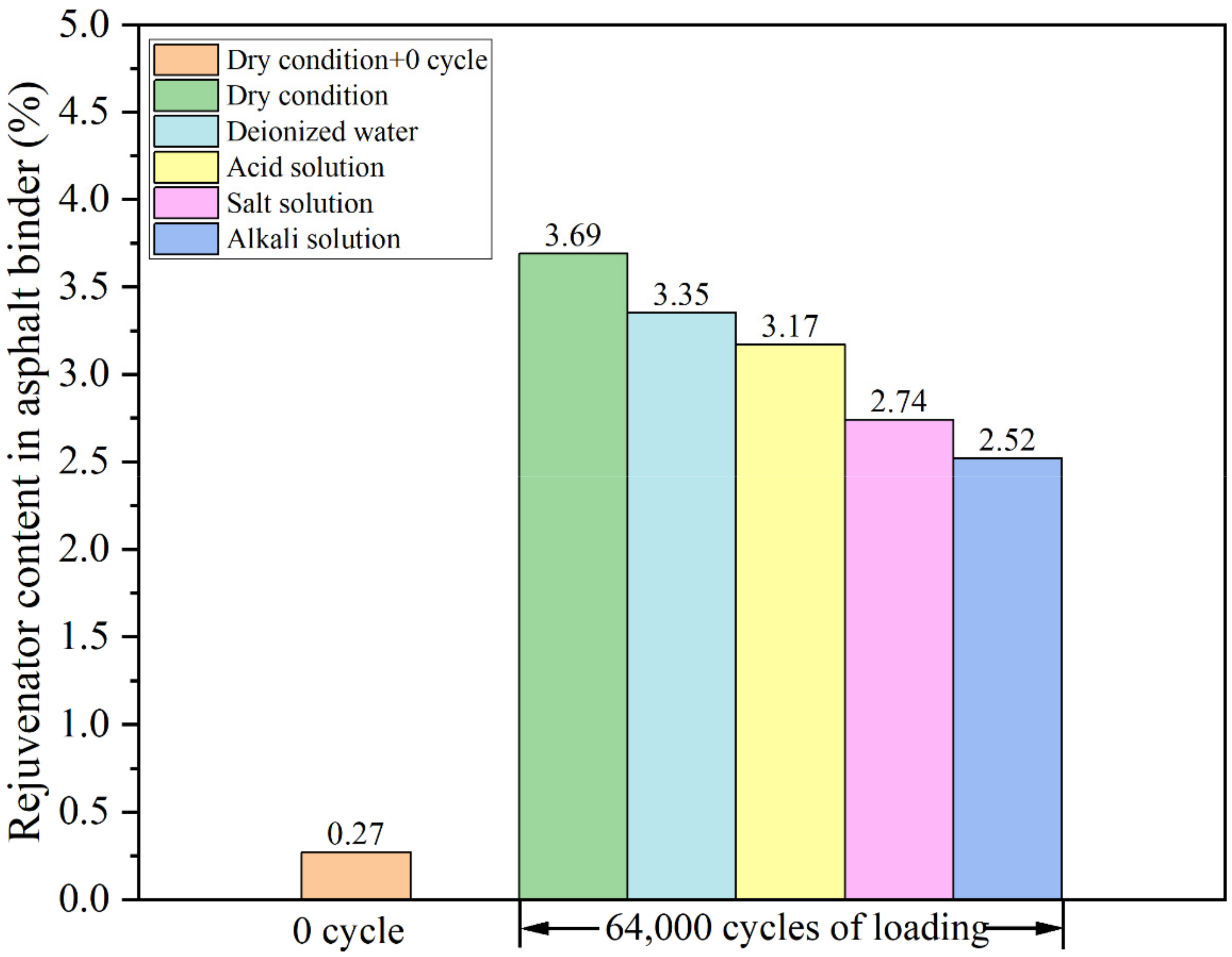
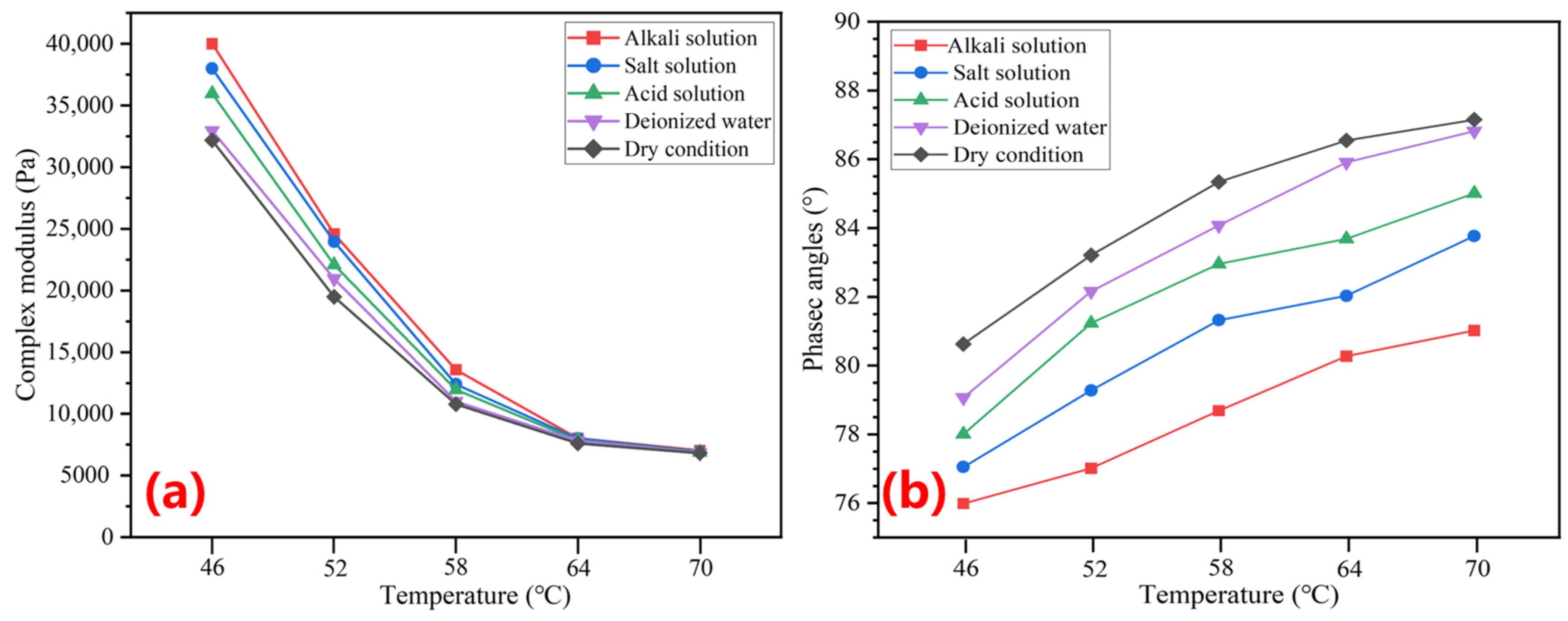

| Raw Material | Purity | Supplier |
|---|---|---|
| Sodium alginate | CP | Sinopharm Chemical Reagent (Shanghai, China) |
| Anhydrous calcium chloride | CP | Sinopharm Chemical Reagent (Shanghai, China) |
| Tween 80 | AR | Sinopharm Chemical Reagent (Shanghai, China) |
| Sunflower oil | Food grade | Arowana Group Co., Ltd. (Beijing, China) |
| H2SO4 | CP | Sinopharm Chemical Reagent (Shanghai, China) |
| NaCl | CP | Sinopharm Chemical Reagent (Shanghai, China) |
| NaOH | CP | Sinopharm Chemical Reagent (Shanghai, China) |
| Item | Value |
|---|---|
| Appearance | Light yellow liquid |
| Main component | Fatty acid |
| Density (15 °C) | 0.935 g/cm3 |
| Viscosity (60 °C) | 0.285 Pa·s |
| Flash point | 230 °C |
| Test | Origin | Test Parameter |
|---|---|---|
| SEM | Gemini 300 Zeiss Oberkochen, Germany | Shooting area: Capsule section Spray material: Pt powder Spray time: 30 s |
| UCT | Instron 5967 Instron Norwood, America | Loading speed: 0.5 mm/min |
| TGA | STA449F3 Netzsch Selb, Germany | Temperature: 40–800 °C Heating rate: 10 °C/min Protect gas: N2 Injection rate: 20 mL/min |
| FTIR | Nicolet 6700 Thermo Fisher Scientific Waltham, MA, America | Chip type: KBr Scan range: 4000–400 cm−1 Scan time: 64 cycles |
| DSR | Smartpave 102 Anton paar Graz, Austria | Strain: 0.5% Frequency: 10 rad/s Temperature: 30–80 °C Plate diameter: 25 mm |
Disclaimer/Publisher’s Note: The statements, opinions and data contained in all publications are solely those of the individual author(s) and contributor(s) and not of MDPI and/or the editor(s). MDPI and/or the editor(s) disclaim responsibility for any injury to people or property resulting from any ideas, methods, instructions or products referred to in the content. |
© 2023 by the authors. Licensee MDPI, Basel, Switzerland. This article is an open access article distributed under the terms and conditions of the Creative Commons Attribution (CC BY) license (https://creativecommons.org/licenses/by/4.0/).
Share and Cite
Li, Z.; Wang, H.; Wan, P.; Liu, Q.; Xu, S.; Jiang, J.; Fan, L.; Tu, L. Healing Evaluation of Asphalt Mixtures with Polymer Capsules Containing Rejuvenator under Different Water Solutions. Sustainability 2023, 15, 15258. https://doi.org/10.3390/su152115258
Li Z, Wang H, Wan P, Liu Q, Xu S, Jiang J, Fan L, Tu L. Healing Evaluation of Asphalt Mixtures with Polymer Capsules Containing Rejuvenator under Different Water Solutions. Sustainability. 2023; 15(21):15258. https://doi.org/10.3390/su152115258
Chicago/Turabian StyleLi, Zhifeng, Huan Wang, Pei Wan, Quantao Liu, Shi Xu, Jian Jiang, Lulu Fan, and Liangliang Tu. 2023. "Healing Evaluation of Asphalt Mixtures with Polymer Capsules Containing Rejuvenator under Different Water Solutions" Sustainability 15, no. 21: 15258. https://doi.org/10.3390/su152115258







